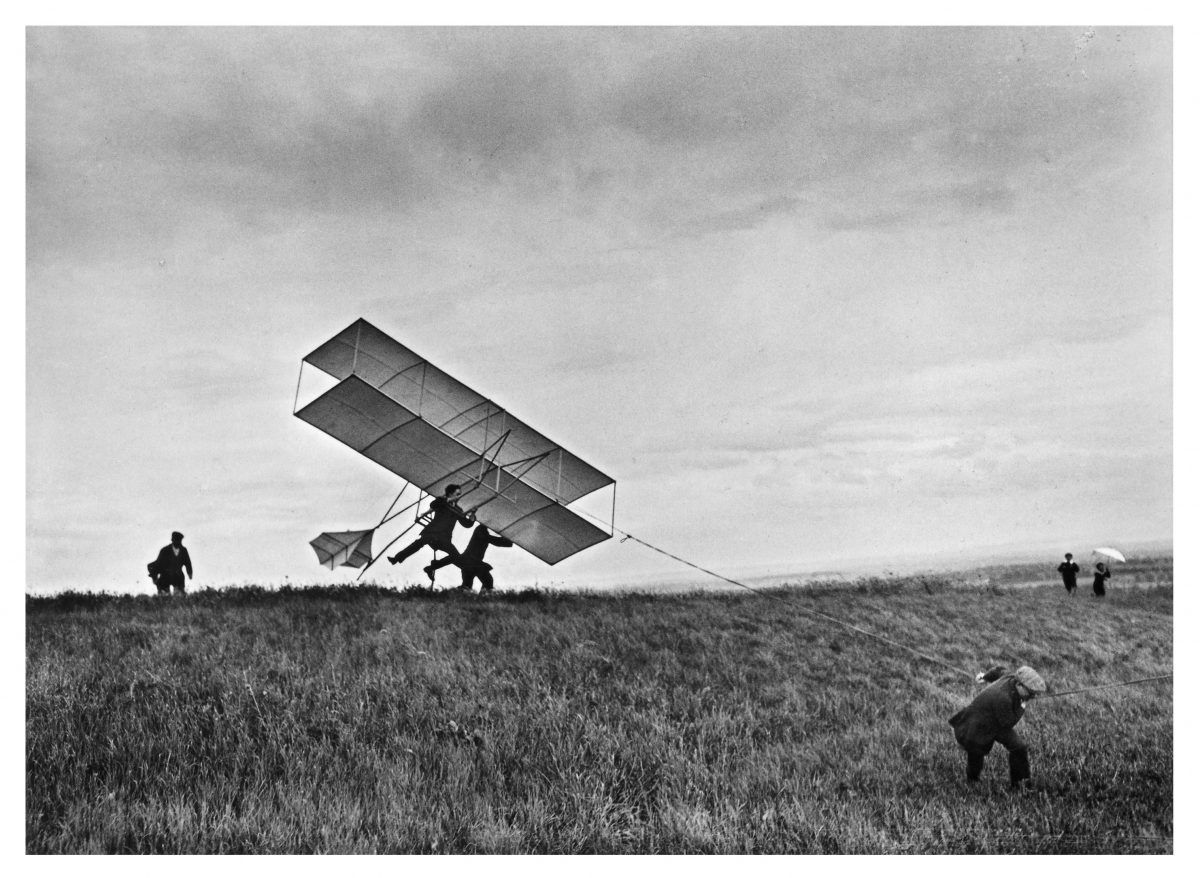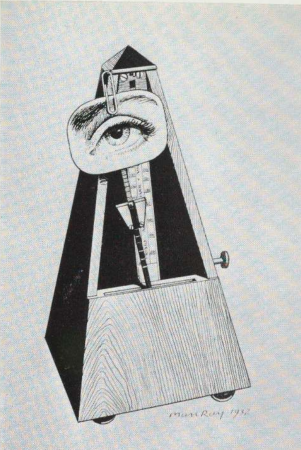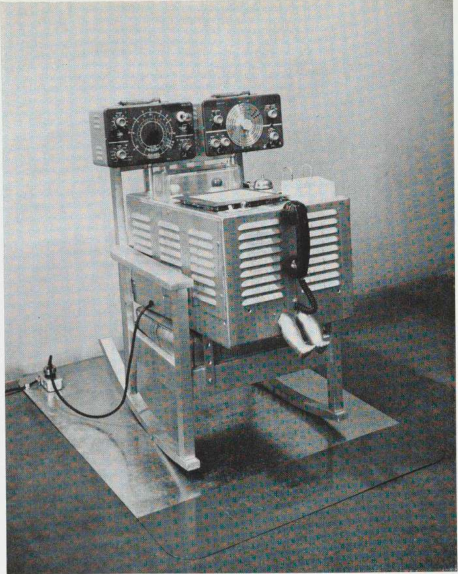created 2025-03-26, & modified, =this.modified
rel: Software Information Technology Its New Meaning for Art, catalogue 1970
Why I’m reading this
While reading Software Information Technology Its New Meaning for Art, catalogue 1970 I learned about this Museum of Modern Art exhibit from the 60s.
I found this catalogue, and immediately knew that I had to buy a physical copy. The neatest thing about it, is that front cover is metal!
via monoskop - The Machine as Seen at the End of the Mechanical Age was one of the most important exhibitions of the 1960s dealing with art and technology. The show was held at The Museum of Modern Art, New York, 25 November 1968 - 9 February 1969. Its curator K.G. Pontus Hultén described it as a “collection of comments on technology by artists of the Western world,” particularly in the modern age when “the mechanical machine - which can most easily be defined as an imitation of our muscles - is losing its dominating position among the tools of mankind; while electronic and chemical devices - which imitate the processes of the brain and the nervous system - are becoming increasingly important.”
While the individual contents are light, this is proving a tough to read book, as each heading causes a curious chase outside the pages.
The Machine as Seen at the End of the Mechanical Age was one of the most important exhibitions of the 1960s dealing with art and technology. The show was held at The Museum of Modern Art, New York, 25 November 1968 - 9 February 1969. Its curator K.G. Pontus Hultén described it as a “collection of comments on technology by artists of the Western world,” particularly in the modern age when “the mechanical machine - which can most easily be defined as an imitation of our muscles - is losing its dominating position among the tools of mankind; while electronic and chemical devices - which imitate the processes of the brain and the nervous system - are becoming increasingly important.”
Technology is undergoing a critical transition. We are surrounded by the outward manifestation of the culmination of the mechanical age. Yet at the same time, the mechanical machine - which can most easily be defined as an imitation of our muscles, is losing its dominance amongst the tools of mankind, while emulation of brain and nervous system are becoming increasingly important.
Pierre Jacquet-Droz (1721-1790) Young Writerllm
Aristotle or his pupil Strato wrote the Mechanica the oldest engineering textbook.
Nature often operates contrary to human expediency; for she always follows the same course without deviation; whereas human expediency is always changing. When, therefore, we have to do something contrary to nature, the difficulty of it causes perplexity, and art has to be called to our aid.
In the 19th Century it was finally realized that a perpetual machine was impossible; machines would always require great labor to keep them functioning. The tremendous increase in manufacture also demanded that more material be constantly sought to keep the machines fed. A reckless exploitation of the earth’s natural resources resulted. Whole geographical areas became regarded as nothing but providers of raw materials - sources that could be used and depleted. Mass production had so fragmented manufacture into isolated processes that it robbed the worker of any identification with what he produced; he lost his sense of pride and purpose, and naturally design suffered as well.
William Morris, a man of strong social conscience, followed Ruskin in avoiding the problems of mechanization chiefly by disassociating himself from it. In his romantic belief, only renunciation of industrial production could lead a return to the guild system of medieval craftsmen that would recover lost humanistic values.
Futurists believed technology represented the dynamic means which they hoped to overcome the stagnation of Italy. Before the title of Futurism was decided, Marinetti thought about “electricism” and then “dynamism.” But the futurist’ vision was quite superficial, as they inherited the Impressionists tendency to look at the appearance of things.
Duchamp who began as a Cubist, soon developed his concepts into a philosophical and metaphysical system. His meditations on movement and machines led him into previously unexplored regions. He rapidly passed through his preliminary interest in the outward aspect of machines to create a new kind of visual metaphor. This enabled him to express complex ideas and that involved, among other things, non Euclidean geometry, chemistry and alchemy.
Tristan Tzara about Dada
No one can escape the machine. Only the machine can enable you to escape from destiny.
Leonardo da Vinci
In his surviving notebooks, there are more than 500 sketches that deal with the nature of flight and with flying machines. Leonardo concerned himself with many kinds of aeronautical devices.

A bird is an instrument working according to mathematical law, which… is within the power of man to reproduce.
All of his early sketches are based on misunderstandings of the up and down movement of birds’ wings when they fly. Only at the discovery of the camera could flight be accurately studied. His studies had no direct influence on aviation.
Thought
I always understood this with Muybridge but it is profound. My human eyes will only do so much to confirm facts about the world. Even now, I only know of much through the images I see. I cannot see them as they are in real time, like trying to observe the flutter of a bird’s wing.
It is probably this unease, limit and inwardness that cripples a lot of thought, or leads to conspiracy.
Machine-People and Machine-Animals
The philosophical problem was set forth by Descartes, who in his Discourse on the Method drew a distinction between non-spatial mind and space-occupying matter:
By body I understand all that can be terminated by a certain figure; that can be comprised in a certain place… that can be moved in different ways not indeed of itself, but by something foreign to it by which it is touched.. for the power of self-motion, as likewise that of perceiving and thinking, I held as by no means pertaining to the nature of the body; on the contrary, I was somewhat astonished to find such faculties existing in some bodies.
In the automatons, the intricate machinery was always completely concealed. Vaucanson’s duck is perhaps the most famous automaton that has ever existed. Already as a child Vaucanson had built angels with wings that moved so and priests that functioned automatically.
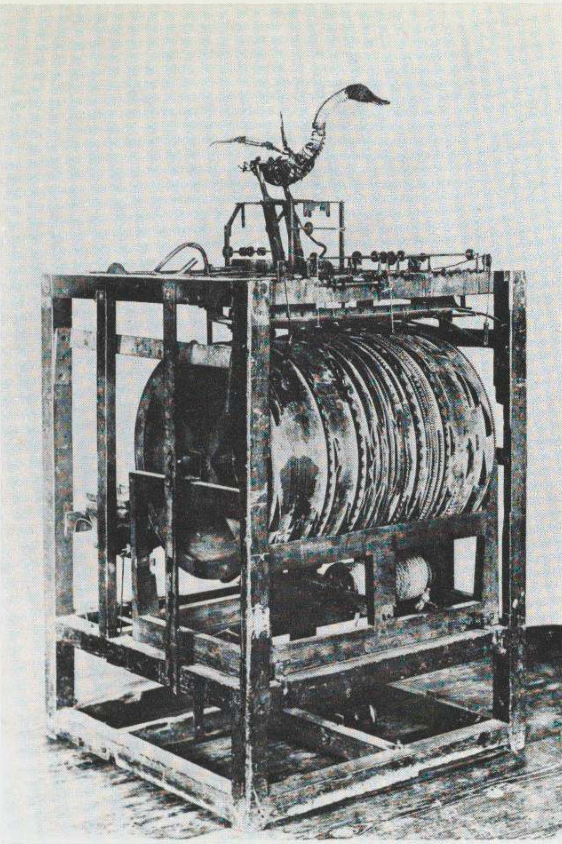
an artificial Duck made of gilded copper which drinks, eats, quacks, splashes about on the water and digests his food like a living Duck
Voltaire on it “the rival to Prometheus.” The duck was exhibited with great acclaim, fell to ruins, was repaired, lost, and rediscovered, and is last recorded in the 1860s.
Young Writer: When the mechanism started the boy dips his pen in the inkwell, shakes it twice, places his hand at the top of the page and pauses. As the lever is pressed again, he begins to write, slowly and carefully, distinguishing in his characters between the light and heavy strokes.
To contemporary spectators the little writer must have seemed almost intolerably perfect. He must have inspired feelings of curiosity, admiration, and probably also paralyzing inferiority.
They are considered to be among the remote ancestors of modern computers.
Flying Man
Restif de la Bretonne gives a detailed description of this flying man. Victorin’s experiments are motivated by his love for the beautiful Christine. He longs to take her away and place her in a nest on the “Inaccessible Mountain” far from her parents. Aided by a friend, he studies the flight of birds and decides he can make two enormous wings to fly.

Charles Green
Charles Green was a 19th century astronaut. In 1836 he covered 480 miles form London to Nassau in Germany. His craft was subsequently called “The Nassau.” Mr. Cocking joined Green of his flights and tried to use the apparent way that umbrellas fall from a height, to survive a high altitude drop. Despite protestations that this would not work, he leapt.
When they had reached some 3K feet, Green warned him once more but Cocking cut the rope that tied him to the balloon, plunging through the air and covering the whole distance in a minute in a half. People rushed to the place where the parachute had fallen and found the poor man absolutely crushed.

Steamboats and Sailing Vessels
Though the great sailing ships with their flexible and adaptable tackle are great achievements (that remained almost the same form for 350 years) they seemed based on a non-mechanistic conception. They derive power by operating in direct collaboration with the wind, whereas steamboats apply another source of energy, intent to defying and subjugating natural forces.
There were many attempts to use sails for locomotion on land.

James Boydell’s Traction Engine (1857)
A dreadnaught wheel is a wheel with articulated rails attached at the rim to provide a firm footing for the wheel to roll over, they have also been known as endless railway wheels when fitted to road locomotives, and were commonly fitted to steam traction engines. They have also been known as endless railway wheels when fitted to road locomotives, and were commonly fitted to steam traction engines.

Chronophotographic gun
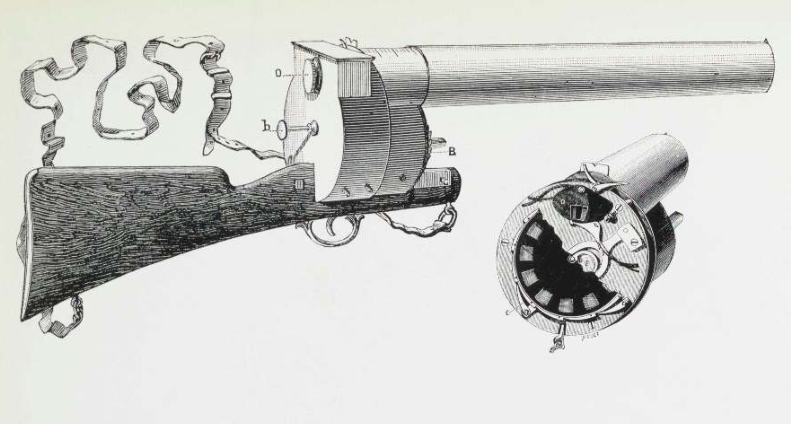 The chronophotographic gun is one of the ancestors of the movie camera, invented by Etienne-Jules Marey in 1882.
The chronophotographic gun is one of the ancestors of the movie camera, invented by Etienne-Jules Marey in 1882.
He was a scientist devoted to the study of movement. To aid himself he made a series of apparatuses for observing and recording movements that for one reason or other the eye cannot perceive.
The barrel housed a camera lens and he could register successive stages of a bird’s flight.
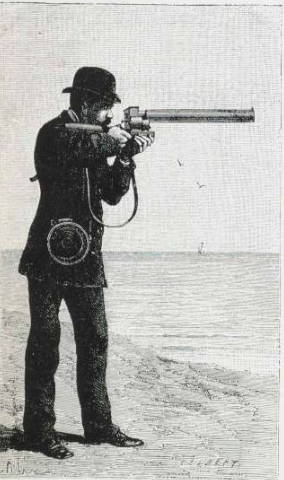
Lumiere Brothers presentations
The other invited guests and I found ourselves before a little screen… and after a few moment a photograph of the Place Bellecoer at Lyons was projected. Somewhat surprised, I just had the time to say to my neighbor: “They’ve put us to all this bother for nothing but a magic-latern show. I’ve been doing those for years.” Scarcely were the words out of my mouth, when a horse dragging a truck began to walk towards us, followed by other wagons and then by pedestrians – in a word, the whole life of street. At this spectacle we remained open-mouthed, stupefied and surprised beyond words.
At the end of the performance, delirium broke out, and everyone asked himself how it was possible to obtain such an effect.
Pierre Selmersheim
rel: Goodyear’s Illuminated Tires Promised a Whole New Frontier in Car Fashion
In France 1895 - competitions were held in Paris in an attempt to find more beautiful forms for automobiles.
Designs were made inspired by
- sedan chairs
- gondolas
and featured concealed rococo gilt-framed panels paneled with flowers.
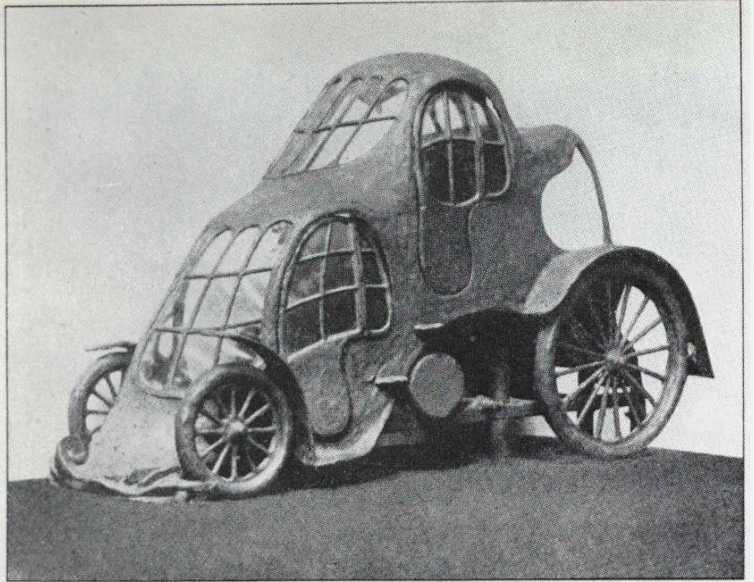 The winner, was the only one who has manifested a half-hearted desired to leave the beaten track to which we are confined and break old molds.
The winner, was the only one who has manifested a half-hearted desired to leave the beaten track to which we are confined and break old molds.
Jacques Henri Lartigue
 He started taking photographs when he was seven. He was one of the first artists to use the Kodak Brownie camera for snapshots.
He started taking photographs when he was seven. He was one of the first artists to use the Kodak Brownie camera for snapshots.
In taking the picture, he moved his camera left to right following the car. The interesting distortion added to the impression of speed, is the result of the focal plane shutter that operated from bottom to top. Images made with a similar apparatus established a photographic convention for what a speeding automobile should look like.

Jacques showed a remarkable examples of a what a machine - the camera – could do in the hands of someone without preconceived ideas of how it should be used.
Giacomo Balla
Manifesto of Futurism summoned Italian intellectuals to “make a violent rupture from the past, break in the mysterious portals of the Impossible” and open a way to the future.
The automobile at this time, represented the ultimate liberty of the individual who, at the wheel of a monster car, could be a kind of superman terrorizing the countryside. He was a kind of heroic figure, a modern centaur, one with his machine and enjoying the sensation that no mortal before him had experienced.

Giorgio de Chirico - The Anxious Journey
In his veneration of the past, Giorgio was the antithesis of his contemporaries, the Futurists. A recurring motif in his paintings of the years seemed to be the lack of connection between large open spaces of city squares and their surrounding buildings, and the mechanical world of the railroad.
His father was an engineer constructing railroad lines.
an oneiric, menacing phantom, recognized suddenly, as when one is aware of the motionless snake in one’s path… The nightmarish reality of the locomotive is sharpened by is emergence at the edge of a vertiable labyrinth of arches, winding in and out, leading nowhere. The painting is clearly a dream image, expressing the terror of being lost in a railroad station before an important journey, of trying desperately to locate a train, only to discover it finally at the end of an inaccessible corridor.
Joseph Stella
New York Interpreted The Skyscrapers
To Stella, NY was the embodiment of all elements of modern civilization, and he wanted to render it thus. The city appeared to him as an enormous lattice, constructed by barbarian cyclopes and constantly moved by vibrations of light and nocturnal sound.

Duchamp
Duchamp’s bride is depicted as a well-oiled machine running on “love gasoline.” There are no recognizable human forms, and no true machine forms either.
Symbols like levers, shafts and so forth were both too simple and too obtrusive. Duchamp penetrated into a more basic form of science – chemistry. The power inherent in chemistry are of course more independent of man than is mechanical energy. They involve natural elements are are less subject to external control, and also have to do with the liquids of the body.
Question: Would you comment on the usage of modern machines and science in your work?
Duchamp: People living in a machine age are naturally influenced either consciously or unconsciously by the age they live in. I think I was conscious enough when I introduced derision into that sacrosanct era. Humor and laughter – not necessarily derogatory derision – are my pet tools. This may come from my general philosophy of never taking the world too seriously for fear of dying of boredom.
 The Large Glass can be read as an intricate machine. Its mechanics are described in detail in the documents regarding its genesis.
The Large Glass can be read as an intricate machine. Its mechanics are described in detail in the documents regarding its genesis.
The most intimate and sentimental feelings and relations of the human race are treated in the language of an instruction manual; and the relations between the bride and her bachelors are hardly conventional ones.
In 1913 Duchamp fastened a bicycle wheel to a stool as an invitation to everyone to spin it. It was the first of his readymades.
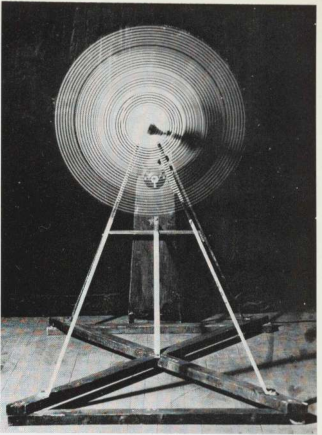 Duchamp was interested in the theories of Poincaré and higher dimensions. Underlying these machines is the concept of this gliding system of dimensions and realities, our world being a three-dimensional space, a shadowof higher dimensional realities.
Duchamp was interested in the theories of Poincaré and higher dimensions. Underlying these machines is the concept of this gliding system of dimensions and realities, our world being a three-dimensional space, a shadowof higher dimensional realities.
According to Man Ray Duchamp came to him with projects for making three-dimensional movies. Because of technical difficulties and the lack of capital, the project that would have been one of the first 3D films was abandoned.
He used the Rotary Demisphere for this, Anemic Cinema

Picabia
Tied to Duchamp, for both men all existing modes of art seemed inadequate for the Expression of modern concepts, and therefore new means had to be found.
A daughter born without a mother.
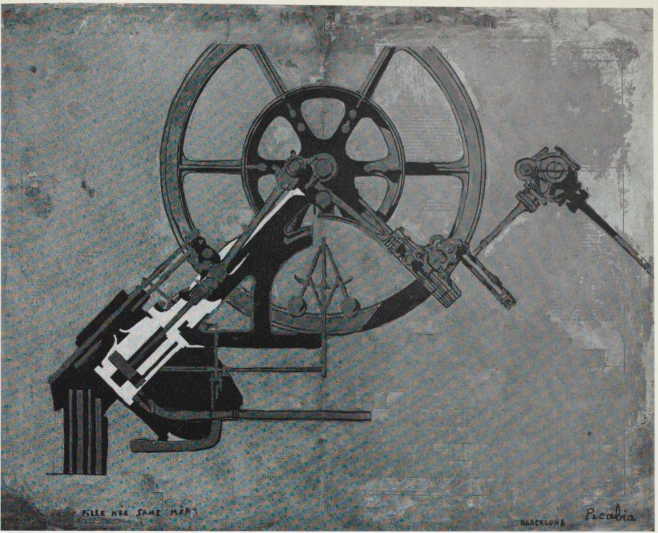 For Picabia, machines represented a new unsentimental, “mechanical” kind of life that he tried to lead, free of any conventional restrictions or responsibility. The idea that machines have no morals he found highly attractive.
For Picabia, machines represented a new unsentimental, “mechanical” kind of life that he tried to lead, free of any conventional restrictions or responsibility. The idea that machines have no morals he found highly attractive.
Raoul Hausmann
rel:Dada - Art and Anti-Art Hannah Höch
 Hausmann was one of the first to use collage form.
Hausmann was one of the first to use collage form.
To have an idea for an image and to find the photos that I can express it are two different things.
For him being a Dadaist meant having a keen sense of perception and seeing things as they really are. Whereas the Germans thought themselves a “nation of thinkers and poets” actually Hausmann’s view “the ordinary man has no more capacities than those that chance has glued onto the outside of his skull, his brain remains empty.”
To express, “the spirit of our time” with readymade mechanical ways of thinking and acting, he selected a wooden hairdresser’s dummy. The head has a naive expression, quite lovable and touching but lacks any capacity for human feeling. Haussmann has shown it, and its features, being measured and numbered, in a hard mechanical way.
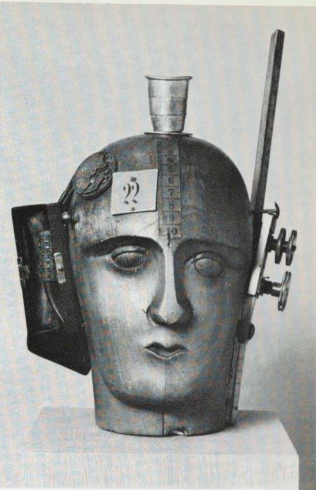
Der Geist Unserer Zeit – Mechanischer Kopf specifically evokes the philosopher George Wilhelm Friedrich Hegel (1770–1831). For Hegel…everything is mind. Among Hegel’s disciples and critics was Karl Marx. Hausmann’s sculpture might be seen as an aggressively Marxist reversal of Hegel: this is a head whose “thoughts” are materially determined by objects literally fixed to it. However, there are deeper targets in western culture that give this modern masterpiece its force. Hausmann turns inside out the notion of the head as seat of reason, an assumption that lies behind the European fascination with the portrait. He reveals a head that is penetrated and governed by brute external forces.
Kurt Schwitters
rel: In Search of Lost Art - Schwitter’s Merzbau
Though associated with Dadaists, he shared a love for nonsense with, Schwitters stood apart and even opposed some of their concepts. Schwitters was strongly pro-art and content to create his own for private enjoyment. His approach was highly personal and complex.
In 1918 he began a special kind of collage out of discarded scrap of paper and bits of junk, that he called Merz after the word Kommerz that he had cut from an advertisement.
He wrote a description for a completely irrational and unrealizable Merz-stage, a theater-machine that would be a total work of art dependent on sensuous rather than literary experience.
Ettore Bugatti
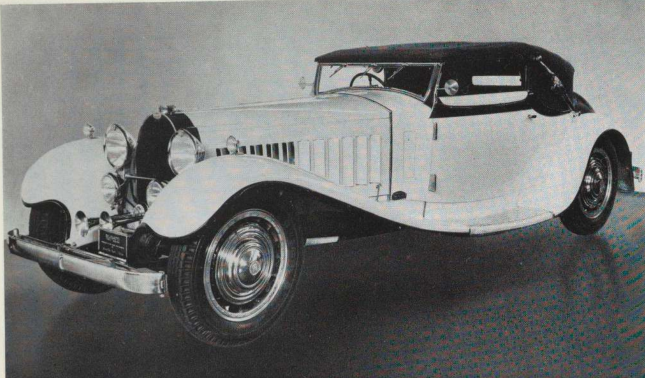
Thought
There’s this narrative of car-erotics, or car-personalities that can be drawn from here and recent readings.
That modern faux-country adoration of the pickup truck and identity associated with it.
Then we see a comment above, and in The Second Digital Turn - Design Beyond Intelligence by Mario Carpo with Bezier.
What is your car?
The Bugatti Royale is without a doubt the culmination of the heroic period of the automobile when optimism and confidence in this machine were still unclouded.
He contemplated the work of his brother, a specialist in animal sculpture. Thinking he could never produce something of equal perfection, he gave up painting and combined his creative impulses with mechanics. In this new place of artwork he created over nine thousand cars.
The Bugatti Royale was already an anachronism when it arrived, ostentatious in size.
Buckminster Fuller
 The Dymaxion Car, photographed outside of the Chicago’s World Fair.
The Dymaxion Car, photographed outside of the Chicago’s World Fair.
Conventional cars have forced on modern cities a complete change of urban planning and function. There have been reports of a scheme proposed in the Soviet Union to adapt cars to towns. Small, very simple electric automobiles operated by token, and owned by the state or municipality would be offered to anyone who passed a simple test and paid an annual fee. Each night the cars would be delivered to where they would be wanted in the morning, but since most cars would be picked up where they had been left there would be little need for this nighttime towing. Outside meters would show where batteries were running low, and they would be replaced by service stations.
Object To Be Destroyed - Man Ray
Cut out the eye from a photograph of one who is loved but is not seen anymore. Attach the eye to the pendulum of a metronome and regulate the weight to suit the tempo desired. With a hammer well-aimed, try to destroy the whole with a single blow.
“The title was Object To Be Destroyed and I really intended to destroy it one day.” He was at a gallery with who had organized the show when youngsters came in and announced that they were protesting against the Dadaists and Surrealists.
On the way out one grabbed the metronome and disappeared with it..
”Afterwards I had an interesting session with the insurance expert… First he offered to replace the cost of the metronome, a trifle. I pointed out that one did not replace a work of art, a painting, with brushes paints and canvas. He conceded the point, since I was a well known artist he would pay the full value of the insurance. Then assuming a more intimate tone, he voiced his suspicion that I might with this money buy a whole stock of metronomes. That was my intention I replied; however I assured him one thing – I’d change the title – instead of Object To Be Destroyed I’d call it Indestructible Object
Rube Goldberg
Underlying this is the idea that something man can do in a very simple, direct way can also be accomplished, through an elaborate roundabout and risky system, by a machine.

Bruno Munari
Bruno created his Useless Machines.
With the “useless machines”, he was interested in exploring the time-space continuum, how to make a work of art that could interact with the environment and change accordingly.
 Munari gave back the spring its own unregulated behavior, by adding two more springs in the form of thin rods that support disc, he created a wriggling dance that goes on a while the force of the spring is running down; then it must be rewound. The motor is glorified, not heroically but poetically.
Munari gave back the spring its own unregulated behavior, by adding two more springs in the form of thin rods that support disc, he created a wriggling dance that goes on a while the force of the spring is running down; then it must be rewound. The motor is glorified, not heroically but poetically.
Jean Tinguely
Tinguely’s art satirized automation and the technological overproduction of material goods.
Tingley’s point of departure from the machinic world of order and precision, was disorder. He pits the emancipated machine against the functional one and gives his creations a glorious life of improvisation, happy efficiency and shabbiness, expressing an enviable freedom.
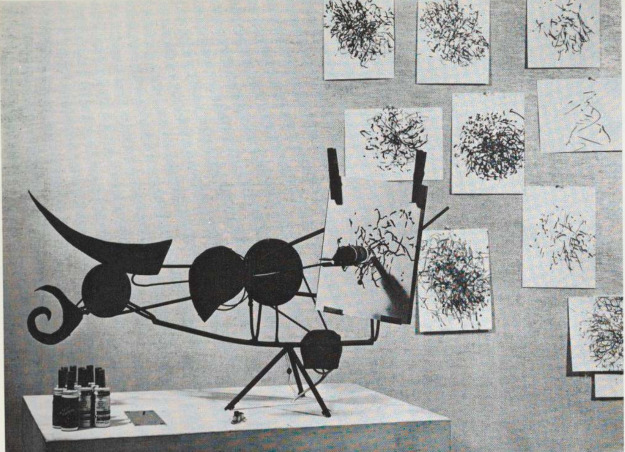 His auto-destructive and auto-creative art machine are among the most engaging ideas of a machine society.
His auto-destructive and auto-creative art machine are among the most engaging ideas of a machine society.
The most important of Tinguely’s self-destroying machines was Homage to New York which destroyed itself in the Sculpture Garden of MoMA in 1960.
 A main theme of his thinking has been to ridicule the practical and rational side of the producing machine, and at the same time emphasize its beauty and flow. For many years he has been trying to find a department store that will let him fill its display windows with a series of machines that will systematically destroy the articles that it offers for sale.
A main theme of his thinking has been to ridicule the practical and rational side of the producing machine, and at the same time emphasize its beauty and flow. For many years he has been trying to find a department store that will let him fill its display windows with a series of machines that will systematically destroy the articles that it offers for sale.
The production of articles that nobody really needs but which occupy the ground floors of all big stores, is one of the many outward symptoms of something basically wrong with overproduction and undernourishment.
The machine immediately eats up its output.
Rene Magritte
 In The Anger of the Gods Magritte has short-circuited two kinds of movement, mechanical and animal motion. He pitches us into the unknown with the question “What is movement anyway?”
In The Anger of the Gods Magritte has short-circuited two kinds of movement, mechanical and animal motion. He pitches us into the unknown with the question “What is movement anyway?”
Friendly Grey Computer by Edward Kienholz
Mechanical devices merely replaced muscular power, but these new devices challenge the very capacities that man has regarded as making him supreme and unique - his ability to think, his brainpower.
Flashing yellow bulb indicates a positive answer. Flashing blue bulb indicates a negative answer. Green jewel button doesn’t light so it will not indicate anything. Computers sometimes get fatigued and have nervous breakdowns hence the chair for it to rest in. If you know your computer well you can tell when it gets tired and sort of blue and in a funky mood. If such a condition seems imminent, turn rocker switch on for ten or twenty minutes. Your computer will love it and work all the harder for you. Remember that if you treat your computer well, it will treat you well.
A question random-found on a card:
Will I ever get a boyfriend?
Hans Haacke
rel: Exploring Combinatorial Methods to Product Sonnets - Oupoco
A “sculpture” that physically reacts to its environment can no longer be regarded as an object. The range of outside factors affecting it, as well as its own radius of action, reach beyond the space it materially occupies. It thus merges with the environment in a relationship that is better understood as a “system” of interdependent processes. These processes evolve without the viewer’s empathy. They become a witness. A system is not imagined; it is real. 1
The cold erects the sculpture by condensation and moisture in the air. Technology, exemplified in the refrigeration unit, artificially produces a natural phenomenon, cold, but instead of exploiting it for some practical reason, such as the preservation of food, the artist has used it to create an image of itself.
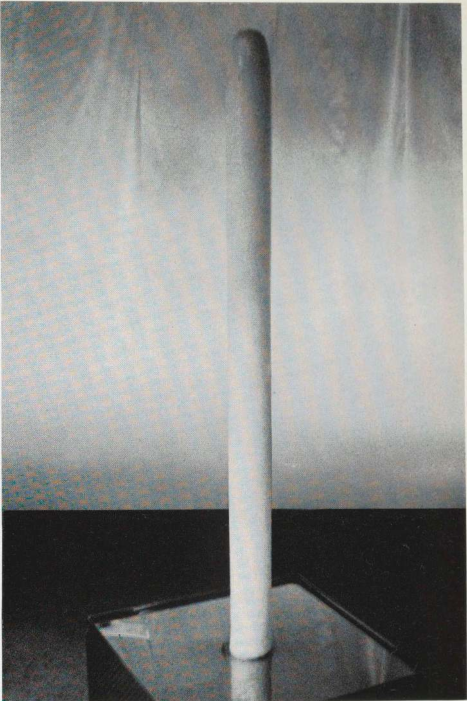
Segment on Nam June Paik


